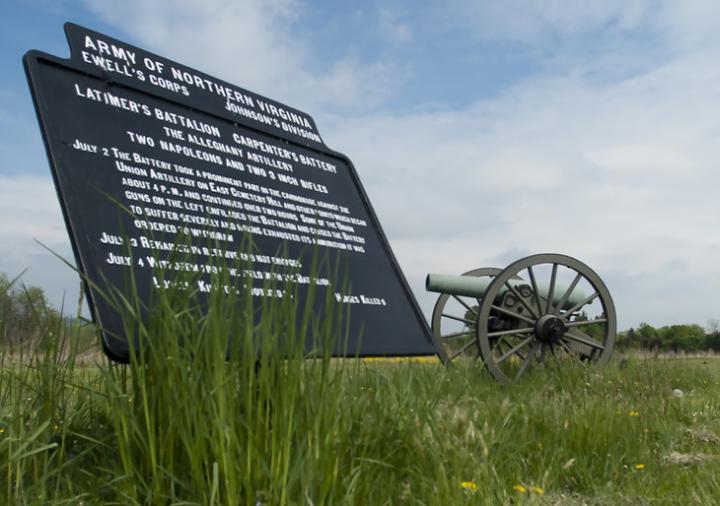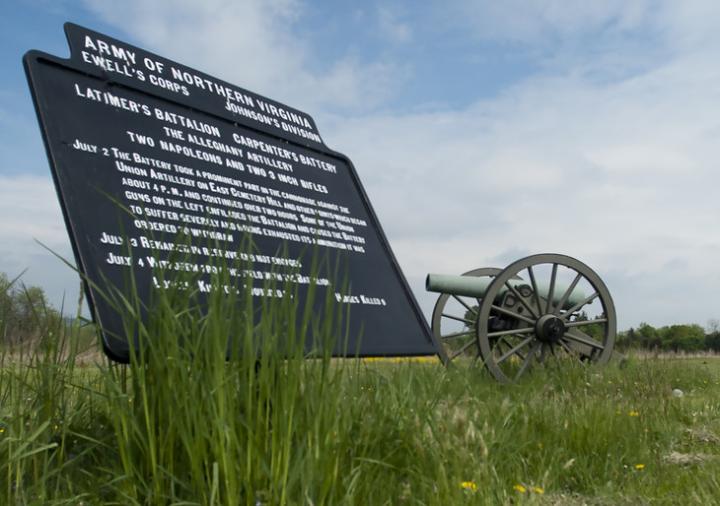
Credit: Patrick Mansell
Visitors to the country's national parks and historic sites may be just a sign — and a few steps — away from improving their health and fitness while enjoying their park trips, according to a team of researchers.
In a study, researchers found that including a sign that encouraged visitors to walk the steps of Civil War soldiers significantly increased the total number of the visitor's steps.
"We wanted to look at the relationship between the park's mission to provide for recreation and preserving the natural resource and health," said Derrick Taff, assistant professor of recreation, park and tourism management, Penn State. "In doing so, we also looked at communication strategies that might influence or persuade visitors to behave in a way that's healthy for them and healthy for the environment."
Taff said the researchers placed two signs at various locations in the Gettysburg National Battlefield encouraging guests to take part in physical activity — for instance, walking sections of battlefield, or climbing steps. The Civil War battlefield is a popular destination for tourists, history aficionados and park enthusiasts, he added.
At the site of Pickett's Charge, a spot near the Virginia Memorial where Confederate troops led an unsuccessful attack on Union positions, the researchers placed a sign encouraging visitors to walk in the steps of the soldiers. When the signs were placed at the site, three times as many people walked the two-mile round-trip path of the charge than on days when there were no signs present, according to the researchers, who reported their findings in a recent issue in the Journal of Recreation, Parks and Tourism in Public Health.
On days when the researchers placed the signs, they observed 13 percent of visitors walking the Pickett's Charge trail, while only 4.6 percent of the visitors walked the trail on days when the signs were not in place.
"This is something for the managers of parks to think about, just how doing very simple things can align with their management objectives," said Taff. "They want people to be physically active, they want them to positively experience Gettysburg, in this example, and truly live that historic moment. In this case, it just took simple signage with a persuasive message to promote a healthy behavior that also aligns with the historic aspect of the park."
However, a similar attempt to use signage to prompt visitor fitness in another part of the battlefield was not successful, according to the researchers. A sign that suggested visitors climb the steps of an observation tower did not increase the number of people climbing those stairs.
"There could be a few reasons why that happened," said Taff. "It could be that this stop is at the end of the tour and that people are more tired and less inclined to take part in exercise, for example. But, what this also tells us is that park managers have to know their park and how it's used to ensure that these types of initiatives are successful."
The researchers added that managers should consider timing, location and the physical nature of the activity being promoted before initiating communication strategies. Taff said park managers also need to balance the desire to promote health and fitness with the condition of the environment.
"You want to do this in a sustainable way and consider the environmental resources, mission of the park, and the visitor experience when promoting human health in these places," said Taff.
He added that the researchers plan to continue investigating how park managers can influence the health and well-being of visitors, while positively enhancing the experience and promoting existing park resources.
The researchers spent 16 days gathering data at the park. Eight days were considered treatment days and eight were controlled days. Trained observers collected the data unobtrusively and recorded their observations in logs.
###
Taff worked with Heather Costigan, research graduate assistant; Peter Newman, professor and department head; and Andrew Mowen, professor, all of recreation, park and tourism management, Penn State; Joshua Morrison Smyth, distinguished professor of biobehavioral health and medicine, Penn State; and Sara B. Newman, graduate student, University of Colorado Boulder.
Media Contact
Matt Swayne
[email protected]
814-865-9481
@penn_state
http://live.psu.edu
Original Source
http://news.psu.edu/story/492470/2017/11/06/research/signs-may-help-may-help-history-buffs-get-more-buff





